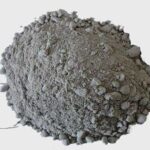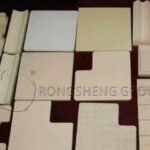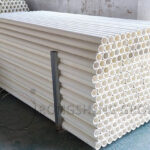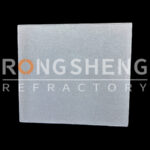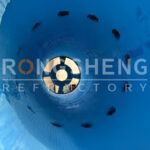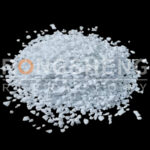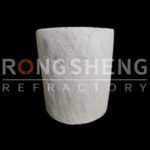Problems Encountered in the Production of Refractory Precast Shapes and Solutions
Refractory precast shapes offer advantages such as convenient and fast on-site construction and a long service life, making them increasingly popular in high-temperature industrial furnaces. The production process for refractory precast shapes is relatively simple, essentially following a series of steps including batching, mixing, molding, and drying. However, production often presents challenges. Rongsheng Refractory Factory has identified several solutions for these common production issues.
Pulverization of Impurities in Bauxite Clinker
Bauxite clinker is a commonly used refractory raw material, and its quality significantly impacts the performance of refractory products. Bauxite clinker, also known as bauxite clinker, is produced by high-temperature calcination of bauxite ore. Its Al2O3 content should be greater than 50%. The impurity content in the product should not exceed 2%, and foreign inclusions such as limestone, loess, and high-calcium and high-iron materials must be avoided. Due to the geological distribution of raw bauxite, it is often associated with limestone and loess. Inadequate post-calcination sorting can lead to the inclusion of impurities such as limestone in the bauxite clinker. Once used in refractory prefabricated parts, the limestone can pulverize during the mixing, forming, drying, firing, and final use, resulting in localized pitting defects. This can affect not only the product’s appearance but also its internal quality. Therefore, before using bauxite clinker, it is necessary to test its pulverization rate. The method used is to take a weight of M1 of bauxite clinker particles (particle size + 3 mm) and immerse them in water for a period of time. The material is then dried at 110°C and passed through a 3 mm sieve. The weight of the particles above the sieve is M2. The pulverization rate can be expressed as:
Pulverization rate (%) = (M1 – M2) / M1 × 100%
A pulverization rate of no more than 0.20% is recommended. If the measured pulverization rate is too high, pretreatment of the raw material is necessary to ensure product quality. This can be achieved by soaking it in water, drying it, and screening it before use.
Pulverization of Brown Corundum
Corundum is increasingly being used as refractory aggregate and powder in monolithic refractories, achieving significant results. Corundum is generally produced from industrial alumina or bauxite through sintering or electric melting. It includes white corundum, sub-white corundum, tabular corundum, high-aluminum corundum, and brown corundum. Brown corundum is produced using electric melting, using light-burned high-aluminum material, coal, and iron scrap as its primary raw materials. The smelting process is divided into two types: shelling furnace and pouring furnace. Shelling furnaces produce material with significantly different crystallinity levels in different parts, and the iron distribution is also wider. Brown corundum produced in pouring furnaces offers uniform quality and good bulk density. However, this uniformity requires less grading, and overall performance may be slightly lower. Based on practical experience, brown corundum produced in shelling furnaces has a much higher probability of pulverization than that produced in pouring furnaces. Using brown corundum with a high pulverization rate to produce preforms can cause localized surface pulverization and cracking after high-temperature firing. It not only affects the quality of the product, but also greatly reduces the firing qualification rate and increases production costs. Since the use of brown corundum with high powdering rate has serious quality risks, it is necessary to test its powdering rate.
Currently, there are no methods or standards for testing the powdering rate. This article uses the following two methods:
Qualitative testing: For each incoming batch of brown corundum, a preformed product is formed according to a specific formula. After drying, it is sintered at a low temperature of 600°C or 1000°C to observe whether it exhibits cracking, thereby determining whether the batch of brown corundum has been powdered.
Quantitative testing: A sample of a certain particle size (3-1 mm) is taken, weighing M3. This sample is boiled in a pressure cooker for 60 minutes (or heated in an electric furnace at 1000°C for 1 hour). After drying, the sample is observed for changes in color and size. The weight of the material passing through a 1 mm sieve is recorded as M4. The powdering rate can then be expressed as:
Powdering rate (%) = (M3 – M4) / M3 × 100%
A powdering rate of no more than 0.10% is considered acceptable. The standard for controlling the powdering rate may vary for different refractory products.
Delamination of Magnesium-Aluminum Preforms Containing Silicon Micropowder
During the production of magnesium-aluminum preforms containing silicon micropowder, surface delamination often occurs on the molded surface, leading to delamination of the finished product. This can seriously impact the service life and yield of the refractory product. There are two types of SiO2 micropowder: one made from high-purity silica and the other a byproduct of producing metallic silicon or ferrosilicon. The latter is the silicon micropowder commonly used in refractory materials. It is hollow, spherical, active, non-agglomerated, and has good filling properties. It undergoes a pozzolanic reaction at room temperature and forms mullite with Al2O3 at high temperatures, both of which contribute to increased castable strength. However, it must possess stable physical and chemical properties; otherwise, the product’s performance will be affected. During the production of refractory preforms, changes in silicon micropowder batches often cause fluctuations in the moldability of the finished product. The most obvious manifestation is delamination of the finished product after molding.
To address this delamination issue, the silicon micropowder used is first screened to homogenize its composition. Secondly, during the mixing process, increase the amount of retarder, appropriately increase the amount of water added, and appropriately extend the wet mixing time before molding. Finally, appropriately lower the curing temperature of the product, which can basically solve the problem.
Flashing of Corundum-Spinel Preforms Containing Aluminum Micropowder
α-Al2O3 micropowder is a commonly used refractory powder in the production of monolithic refractories. Ultrafine α-Al2O3 powder is produced by calcining industrial alumina. Its characteristics include good dispersibility, small particle size, easy sintering at high temperatures, and minimal volume effect. In production, corundum-spinel preforms containing aluminum micropowder often develop a layer of milky white liquid and honeycomb-like pits on the molding surface during curing after molding. These pits are accompanied by bubbles escaping from the pits. Removing the liquid from the molding surface reveals that the molding surface is essentially composed entirely of powder. This phenomenon is known as flashing. The thickness of the powder layer on the molding surface varies depending on the degree of flashing.
Flashing is more pronounced in winter, posing a serious quality risk to prefabricated refractory components. This can lead to uneven microstructure, low strength, decreased thermal shock and corrosion resistance, and a shortened service life. Extensive investigation and analysis have revealed a correlation between flashing and the content of the metal oxides K₂O and Na₂O in the raw aluminum micropowder. When this content is above 0.2%, flashing is virtually nonexistent when forming prefabricated components using this aluminum micropowder mix. However, when this content is below 0.1%, flashing is inevitable and can be quite severe.
Flashing can be alleviated or resolved through the following methods:
- ① Reduce the normal water addition by 0.1-0.3 percentage points.
- ② Adjust the ratio of retarder to accelerator, increasing the accelerator while reducing the retarder.
- ③ Appropriately increase the curing temperature after forming.
- ④ When mixing, add a small amount of fused magnesia fine powder, and the amount added should not exceed 0.5%.
High-Temperature Treatment of Embedded Hook Prefabricated Parts
High-temperature treatment of embedded hook prefabricated parts is a common problem in the production of refractory prefabricated parts. The high-temperature treatment temperature here refers to temperatures above 1100°C. Therefore, direct firing is not an option, as is typical. Certain protective measures must be taken to prevent oxidation during firing of the metal hooks.
To this end, tests were conducted using rebar segments of the same thickness as the hooks. Three approaches were tested: charcoal embedment, coating the rebar segments with an anti-oxidation coating, and wrapping the rebar segments with refractory wool, followed by a castable as an external anti-oxidation layer.
Firing in a high-temperature furnace revealed that the rebar embedded in charcoal embedment remained intact. The rebar coated with anti-oxidation coating exhibited the most severe oxidation. The rebar segments with castable as an external anti-oxidation layer experienced partial oxidation due to microcracks in the castable during firing, resulting in an oxide layer thickness of 1-2 mm.
This demonstrates that charcoal embedment is the optimal approach. During the carbon burial treatment, it should be noted that partial or full carbon burial treatment should be performed according to the structural characteristics of the prefabricated parts.
